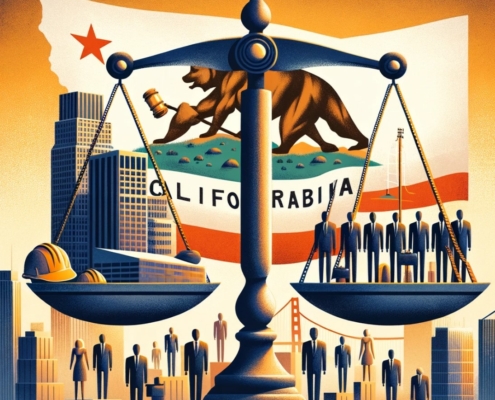Warning: Undefined array key "min_height" in /www/cabusinesslawyercorporate_244/public/wp-content/themes/enfold/config-templatebuilder/avia-shortcodes/columns/columns.php on line 2055
How To Conduct A Workplace And Employee Investigation
A guide on how to conduct a workplace investigation.
By Douglas Wade, Attorney
Email | Call (800) 484-4610
How do you investigate a workplace complaint?
An investigation into a workplace complaint starts with immediately acknowledging the worker’s complaint. Employers in California are required to comply with various state and federal laws that prohibit discrimination, harassment, retaliation, and other unfair employment practices. These include the California Fair Employment and Housing Act (FEHA) and Title VII of the Civil Rights Act of 1964 at the federal level. Conducting an investigation demonstrates the employer’s commitment to upholding these laws and can help prevent potential legal liability.
Further, employers have a legal obligation to maintain a safe and respectful work environment for all employees. Investigating complaints allows employers to identify and address issues such as harassment, discrimination, bullying, or unsafe working conditions. It helps ensure that employees feel valued, respected, and protected from any form of mistreatment.
By promptly investigating workplace complaints, employers can mitigate potential legal liability. Failing to address complaints or ignoring signs of misconduct can result in costly lawsuits and damage to the organization’s reputation. Conducting a thorough investigation demonstrates an employer’s commitment to taking complaints seriously and can be an effective defense if legal action is pursued.
Employees have the right to be free from discrimination, harassment, and other unlawful practices in the workplace. Conducting an investigation allows employers to protect these rights and take appropriate action against those responsible for the misconduct. It shows that the employer is committed to providing a fair and equitable workplace where all employees are treated with dignity.
In California, employers are expected to follow specific procedures when investigating workplace complaints. These procedures may vary depending on the nature of the complaint and the size of the organization. It is essential to consult the California Department of Fair Employment and Housing (DFEH) and seek legal guidance to ensure compliance with the relevant laws and regulations.
In this article, our employment attorney for HR investigation discusses steps that an employer in California should take to conduct a fair and effective investigation of a workplace complaint as follows:
Step 1: Maintain confidentiality
Maintaining confidentiality during a workplace investigation is a critical aspect of the process. It helps protect the privacy of individuals involved, encourages open communication, and safeguards against potential retaliation.
Confidentiality ensures that the identities of the individuals involved in the investigation, as well as the sensitive information disclosed during the process, are kept confidential. This helps protect the privacy and reputation of all parties involved, including the complainant, witnesses, and the accused. It is essential to communicate clearly to all participants about the importance of confidentiality and the potential consequences of breaching it.
Maintaining confidentiality also creates a safe space for individuals to come forward and share their experiences or observations without fear of retaliation or reprisal. It helps foster trust in the investigative process, encouraging employees to provide accurate and honest information. If employees believe that their identities and information will be protected, they are more likely to cooperate fully and disclose relevant details.
Confidentiality is also crucial in preventing potential retaliation against those involved in the investigation. Retaliation can take various forms, such as adverse employment actions, harassment, or a hostile work environment. By maintaining confidentiality, employers can minimize the risk of retaliation and ensure that employees feel safe and secure throughout the investigation process.
It should be noted that while maintaining confidentiality is important, it is also necessary to balance it with the need to gather information and take appropriate action. The employer should limit disclosure of information to only those individuals directly involved in the investigation or who have a legitimate need to know. This may include HR personnel, legal advisors, and relevant management personnel. It is essential to inform all individuals with access to confidential information about their obligations to maintain confidentiality.
Also, confidentiality should not be absolute in all cases. There may be situations where disclosure of certain information becomes necessary to comply with legal obligations or to conduct a thorough investigation. For example, some states or federal laws may require disclosure of certain information to government agencies or in legal proceedings. It is advisable to consult legal experts and ensure compliance with applicable laws and regulations.
Step 2: Ensure protection of those involved
During a workplace investigation, it is crucial for employers to take interim protection measures to safeguard the individuals involved and maintain a fair and safe workplace. Interim protection involves implementing temporary actions to address potential risks and prevent further harm during the investigation process. These measures may include separating the parties involved, adjusting work schedules, or temporarily reassigning job duties to ensure that there is no contact or potential for retaliation between the individuals.
By providing interim protection, employers demonstrate their commitment to employee well-being and create an environment where employees feel safe and supported. These measures also help to preserve the integrity of the investigation process by preventing any potential interference or intimidation. By promptly addressing potential risks and ensuring the safety of all parties involved, employers can maintain a productive work environment and uphold the principles of fairness, respect, and justice.
Step 3: Choose an investigator
The selection of an investigator for a workplace complaint investigation is a crucial decision that can significantly impact the outcome and credibility of the process. A good investigator possesses specific qualities and expertise to conduct a thorough, unbiased, and fair investigation. While HR professionals may have relevant skills, their involvement as investigators raises certain considerations.
When selecting an investigator for a workplace complaint investigation, it is essential to choose an individual who possesses the necessary qualities and expertise for the task at hand. A good investigator should have a solid understanding of relevant laws, regulations, and company policies. They should be impartial, objective, and demonstrate strong analytical and communication skills. It is crucial for investigators to be able to gather evidence, interview witnesses, and assess credibility effectively. They should also have the ability to maintain confidentiality, handle sensitive information, and reach sound conclusions based on the available evidence. Additionally, a good investigator should have experience in conducting workplace investigations and be knowledgeable about the potential complexities and dynamics involved.
While HR professionals may have some of these qualities, there are potential drawbacks to using them as investigators. HR professionals often have pre-existing relationships within the organization and may face conflicts of interest or perceived bias. This can compromise the perceived fairness and objectivity of the investigation. Additionally, employees involved may be hesitant to share sensitive information with HR professionals due to concerns about confidentiality or fear of repercussions. It is important to consider these factors when deciding whether to utilize an HR professional as an investigator.
To ensure an unbiased and credible investigation, organizations may consider outsourcing the investigation to external investigators who have no personal or professional ties to the company. External investigators bring fresh perspectives and can lend credibility to the process, enhancing employee trust and confidence. However, if an internal HR professional is selected as an investigator, steps should be taken to mitigate potential conflicts of interest, such as ensuring they have no personal involvement in the complaint, providing appropriate training, and establishing clear guidelines for their role as an investigator.
Ultimately, the selection of an investigator should prioritize the qualities of objectivity, expertise, and the ability to conduct a thorough and fair investigation. Careful consideration should be given to the specific circumstances of the complaint and the potential advantages and disadvantages of utilizing an internal HR professional versus an external investigator.
Step 4: Create an investigation plan
Creating a well-structured plan for a workplace investigation is essential to ensure an efficient and thorough process. The duration and complexity of the investigation may vary depending on the specific circumstances. For inspiration, take a look at the following example of a four-day plan for a workplace investigation, outlining the interviews to be conducted each day:
Day 1:
- Interview the complainant: Start by interviewing the individual who filed the complaint. Gather detailed information about the incident, including dates, times, locations, and any supporting evidence or witnesses.
- Identify and interview immediate witnesses: Speak with any individuals who witnessed the alleged incident or have relevant information. This may include colleagues, supervisors, or anyone mentioned by the complainant as being present during the event.
Day 2:
- Interview the accused party: Conduct an interview with the individual who has been accused of misconduct. Allow them to provide their version of events and respond to the allegations made against them. Gather any supporting evidence they may have.
- Interview additional witnesses: Speak with any additional witnesses identified during the investigation who were not interviewed on the first day. This could include individuals who were mentioned by the complainant, the accused party, or the initial witnesses.
Day 3:
- Interview relevant supervisors or managers: Speak with the immediate supervisors or managers who were responsible for overseeing the individuals involved in the complaint. Gain insights into their awareness of the incident, any previous complaints, or relevant disciplinary actions.
- Interview any other relevant individuals: Conduct interviews with any other individuals who may have relevant information or insights into the incident, workplace culture, or potential patterns of behavior.
Day 4:
- Conduct follow-up interviews: If necessary, conduct follow-up interviews with any previously interviewed individuals to clarify information, address discrepancies, or gather additional details.
- Document and review findings: Review all gathered evidence, statements, and documentation. Assess the credibility of each interviewee, identify any patterns or inconsistencies, and draw preliminary conclusions based on the available information.
This four-day plan is merely an example, and the actual timeline and sequence of interviews may vary depending on the specific situation. It is important to remain flexible and adapt the plan as needed to ensure a comprehensive and fair investigation. Throughout the process, you should maintain accurate records, document all interviews, and gather any supporting documentation or evidence to support the findings and conclusions reached at the end of the investigation.
Step 5: Write interview questions
During a workplace investigation, interview questions should be carefully crafted to gather relevant information, elicit detailed responses, and assess credibility. The following are some examples of interview questions that can be used during a workplace investigation:
- Complainant Interview:
- Can you provide a detailed account of the incident(s) you are reporting?
- Who else may have witnessed or have knowledge of the incident(s)?
- Have you documented any evidence or preserved any relevant communication (emails, text messages, etc.)?
- Did you report the incident(s) to anyone else? If so, when and to whom?
- Witness Interviews:
- Can you describe the incident(s) you observed or were informed about?
- When and where did the incident(s) occur?
- Did you see or hear anything that supports or contradicts the complainant’s allegations?
- Were there any other individuals present during the incident(s) who might have additional information?
- Have you witnessed similar incidents or behavior in the past?
- Accused Party Interview:
- What is your understanding of the complaint or allegations made against you?
- Can you provide your perspective on the incident(s) in question?
- Were there any witnesses to the incident(s) who can support your account?
- Have you been accused of similar behavior in the past? If so, can you provide any details?
- Supervisor/Manager Interviews:
- Were you aware of the incident(s) or the complaint prior to being notified of the investigation?
- Have you received any previous complaints or concerns about the individuals involved?
- What actions, if any, did you take upon learning about the incident(s) or complaint?
- Additional Interviews:
- Are there any other individuals who might have information or insights related to the incident(s) or the individuals involved?
- Have you observed any patterns of behavior or similar incidents within the workplace?
It is important to tailor the questions to the specific circumstances of the investigation, maintaining a neutral tone and avoiding leading or suggestive questions. Additionally, active listening and follow-up questions are essential to gather comprehensive information and clarify any ambiguities. It is advisable to consult legal counsel or HR professionals to ensure that the interview questions comply with applicable laws and regulations.
Step 6: Stage interviews
Conducting interviews as a workplace investigator requires a careful and methodical approach to ensure fairness, gather relevant information, and maintain the integrity of the investigation process. Below are some guidelines concerning how a workplace investigator should conduct interviews:
- Plan and prepare:
- Review the complaint, relevant policies, and any supporting documentation before the interview.
- Prepare a list of interview questions based on the specific issues and allegations involved in the investigation.
- Determine the order of interviews and ensure a suitable and private location for each interview.
- Establish the tone and build trust:
- Begin the interview by introducing yourself, explaining the purpose of the interview, and ensuring confidentiality.
- Create a comfortable and non-threatening environment to encourage open communication from the interviewee.
- Practice active listening:
- Pay close attention to the interviewee’s responses, non-verbal cues, and emotions.
- Avoid interrupting or imposing personal opinions or judgments during the interview.
- Use active listening techniques, such as nodding, paraphrasing, and asking clarifying questions to ensure a clear understanding of the interviewee’s statements.
- Remain neutral and unbiased:
- Maintain a neutral and objective demeanor throughout the interview.
- Avoid leading or suggestive questions that may influence the interviewee’s responses.
- Treat all interviewees with respect and ensure that they feel heard and understood.
- Gather comprehensive information:
- Ask open-ended questions to encourage detailed responses and provide an opportunity for the interviewee to share their perspective fully.
- Seek specific details, such as dates, times, locations, and any relevant supporting evidence or witnesses.
- Encourage interviewees to provide facts rather than opinions or assumptions.
- Clarify and follow-up:
- Ask follow-up questions to clarify ambiguous or inconsistent statements.
- Seek additional information or examples to substantiate the interviewee’s claims or provide a broader context.
- Allow the interviewee to ask questions or seek clarification if needed.
- Document the interview:
- Take thorough and accurate notes during the interview, capturing key points, statements, and relevant details.
- Avoid paraphrasing or summarizing interviewee statements selectively, strive to maintain objectivity in recording the information.
- Conclude the interview:
- Thank the interviewee for their participation and willingness to provide information.
- Reiterate the confidentiality of the investigation and assure them that their participation will not result in retaliation.
- Provide contact information for any follow-up questions or additional information they may wish to provide.
Step 7: Reach a conclusion
Making a decision as a workplace investigator requires a thorough and unbiased assessment of all the gathered information, evidence, and statements obtained throughout the investigation process. The following is a guideline on how a workplace investigator should approach decision-making:
- Review and analyze:
- Carefully review all the documentation, interview notes, and evidence collected during the investigation.
- Evaluate the credibility, consistency, and reliability of the information obtained from various sources.
- Identify any patterns, commonalities, or inconsistencies in the statements or evidence.
- Consider relevant policies and laws:
- Evaluate the allegations and evidence in light of applicable company policies, procedures, and relevant employment laws.
- Assess whether the alleged conduct violates any specific policies, code of conduct, or legal standards.
- Consult legal counsel or HR professionals to ensure compliance with all legal requirements.
- Weigh the evidence:
- Assess the strength and relevance of the evidence gathered during the investigation.
- Consider the quality of witness statements, supporting documents, and any corroborating evidence.
- Differentiate between factual evidence and subjective interpretations or opinions.
- Balance perspectives:
- Consider the perspectives and statements of all parties involved, including the complainant, accused party, and witnesses.
- Evaluate the credibility, consistency, and motives of each party, recognizing potential biases or conflicts of interest.
- Avoid making assumptions or decisions based solely on personal opinions or preconceived notions.
- Determine preponderance of evidence:
- Determine whether the evidence collected demonstrates that it is more likely than not that the alleged conduct occurred.
- Assess whether the evidence meets the standard of proof required based on the specific circumstances, such as a preponderance of evidence or clear and convincing evidence.
- Document the decision:
- Clearly document the decision reached, providing a detailed explanation of the rationale behind the conclusion.
- Include the key findings, relevant evidence, and the specific policies or laws that support the decision.
- Document any recommended actions, such as disciplinary measures or corrective actions, if applicable.
- Communicate the decision:
- Communicate the decision to the appropriate parties involved, ensuring confidentiality and privacy as required.
- Provide a clear and concise summary of the decision, explaining the rationale and any recommended actions.
- Inform the parties involved about their rights, potential next steps, and any applicable appeal or complaint procedures.
Step 8: Close the investigation
After a workplace investigation decision is made, it is crucial for employers to take appropriate and timely actions to address the findings and maintain a fair and safe work environment. The following are some actions that an employer should consider when responding to the outcome of a workplace investigation:
- Review the investigation findings:
- Thoroughly review the investigation report and the decision made by the investigator.
- Ensure a clear understanding of the facts, evidence, and reasoning behind the decision.
- Determine appropriate actions:
- Assess the severity and nature of the findings to determine the appropriate course of action.
- Consider any recommended actions or measures outlined in the investigation report.
- Consult legal counsel or HR professionals to ensure compliance with relevant laws, regulations, and company policies.
- Address disciplinary measures or corrective actions:
- If the investigation reveals misconduct or policy violations, take appropriate disciplinary measures or corrective actions.
- Apply consistent and fair consequences based on the severity of the misconduct and any established disciplinary policies or procedures.
- Clearly communicate the actions being taken to the parties involved, while respecting confidentiality and privacy as required.
- Implement preventive measures:
- Identify any systemic or underlying issues that contributed to the incident and take steps to address them.
- Implement preventive measures, such as additional training, policy revisions, or changes in procedures, to mitigate the risk of similar incidents in the future.
- Foster a culture of respect, inclusivity, and adherence to company policies through ongoing education and awareness initiatives.
- Communicate with affected parties:
- Communicate the outcome of the investigation to the complainant, accused party, and any other individuals directly affected by the findings.
- Provide a clear and concise summary of the decision, the actions being taken, and any relevant next steps.
- Ensure that individuals are aware of their rights, any available support resources, and the process for raising any concerns or appeals.
- Monitor and follow up:
- Monitor the workplace to ensure that the implemented actions and measures are effective in preventing future incidents.
- Follow up with the parties involved to address any ongoing concerns, provide necessary support, or assess the effectiveness of the resolution.
- Regularly evaluate the impact of the investigation outcome on the work environment and make any necessary adjustments or improvements.
Step 9: Write a report
When writing a summary of the investigation results as a workplace investigator, it is essential to provide a clear and comprehensive report that captures the key findings, analysis, and conclusions of the investigation. The following is an overview of the information that should be included in the final report:
- Introduction:
- Provide a brief introduction to the investigation, including the names and roles of the complainant, accused party, and any other relevant individuals.
- Summarize the nature of the complaint or allegations and the purpose of the investigation.
- Investigation process:
- Describe the steps and procedures followed during the investigation, including the interviews conducted, evidence reviewed, and any relevant policies or laws considered.
- Provide an overview of the timeline and scope of the investigation.
- Background information:
- Include relevant background information about the parties involved, their roles, and any previous incidents or relevant context that may have influenced the investigation.
- Findings:
- Present the factual findings of the investigation, including a summary of the evidence, witness statements, and any relevant documents reviewed.
- Clearly and objectively present the information gathered, distinguishing between facts and opinions.
- Include specific details such as dates, times, locations, and any corroborating or conflicting evidence.
- Analysis and evaluation:
- Analyze the evidence and statements obtained during the investigation, considering their credibility, consistency, and relevance.
- Assess the applicability of company policies, procedures, and relevant laws to the allegations and evidence.
- Consider any mitigating or aggravating factors that may impact the severity of the findings.
- Conclusions:
- State the investigator’s conclusions based on the findings and analysis, indicating whether the allegations were substantiated or unsubstantiated.
- Provide a clear rationale for the conclusions reached, explaining how the evidence and analysis led to the decision.
- If appropriate, recommend any disciplinary actions, corrective measures, or preventive steps to address the findings.
- Recommendations:
- Offer recommendations for remedial actions or improvements to prevent similar incidents in the future.
- Suggest any necessary changes to company policies, procedures, or training programs based on the investigation’s findings.
- Confidentiality and privacy:
- Emphasize the importance of confidentiality and privacy throughout the report, ensuring that sensitive information is handled appropriately and in compliance with applicable laws.
- Appendices:
- Include any supporting documents, evidence, witness statements, or relevant policies that were considered during the investigation.
The report should be written in a clear, concise, and neutral tone, avoiding any personal biases or subjective opinions. Use objective language and focus on presenting the facts, evidence, and analysis in a logical and organized manner. It is advisable to review the report for accuracy and clarity before finalizing and distributing it to the appropriate parties. Additionally, ensure compliance with any legal requirements, company policies, or internal procedures regarding the formatting, distribution, and retention of investigation reports.
Have a quick question? We answered nearly 2000 FAQs.
See all blogs: Business | Corporate | Employment
Most recent blogs:
































